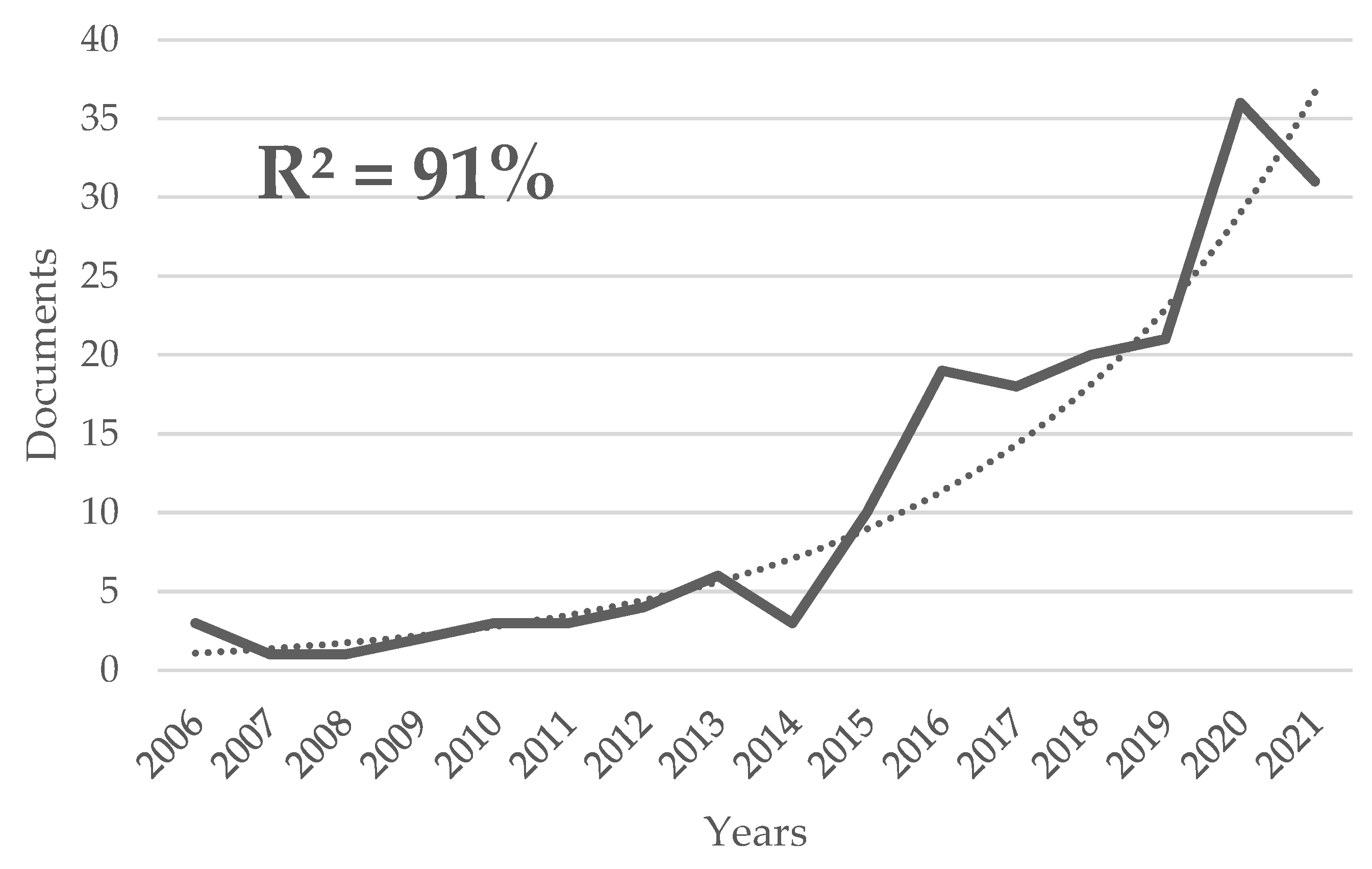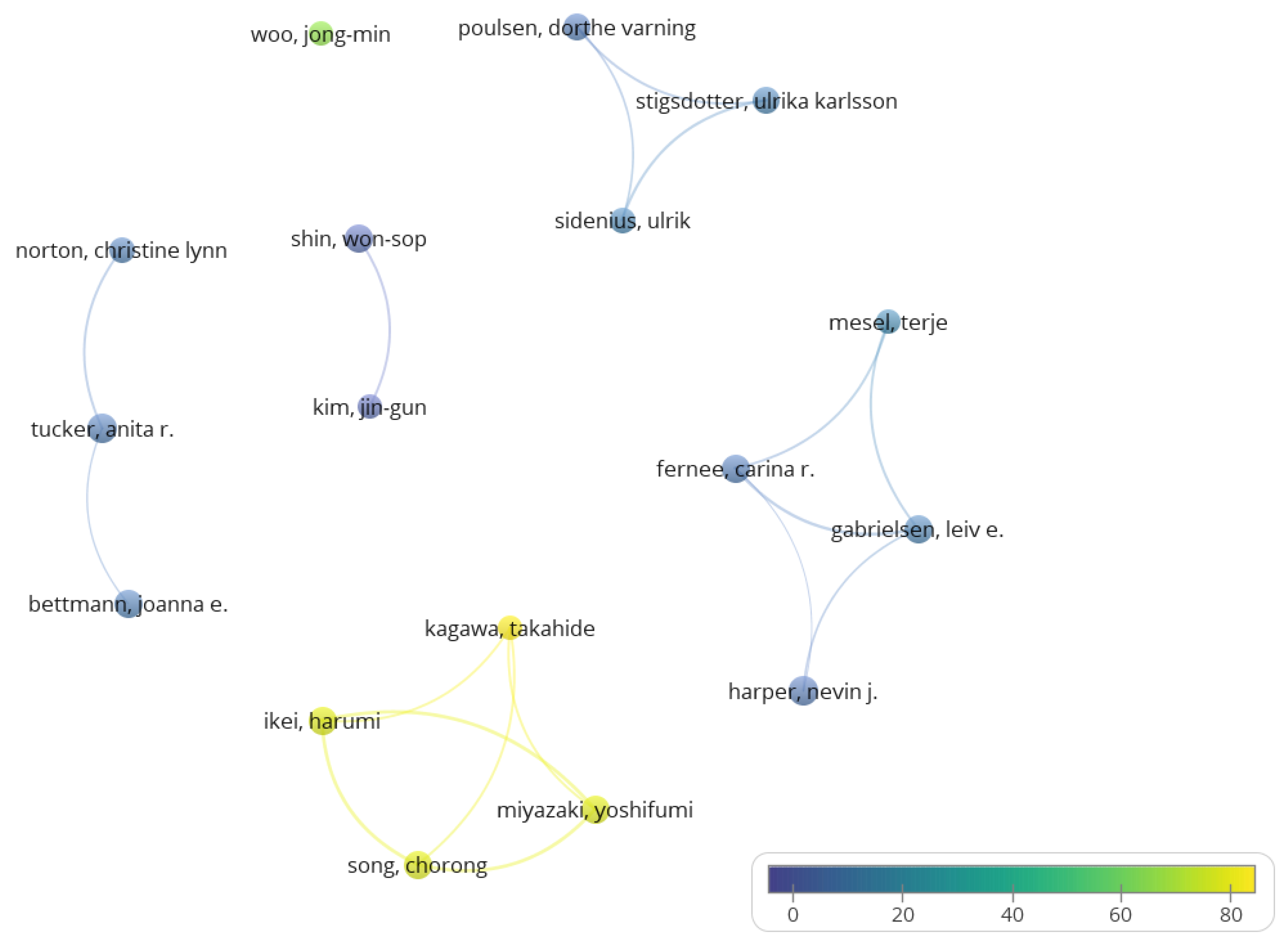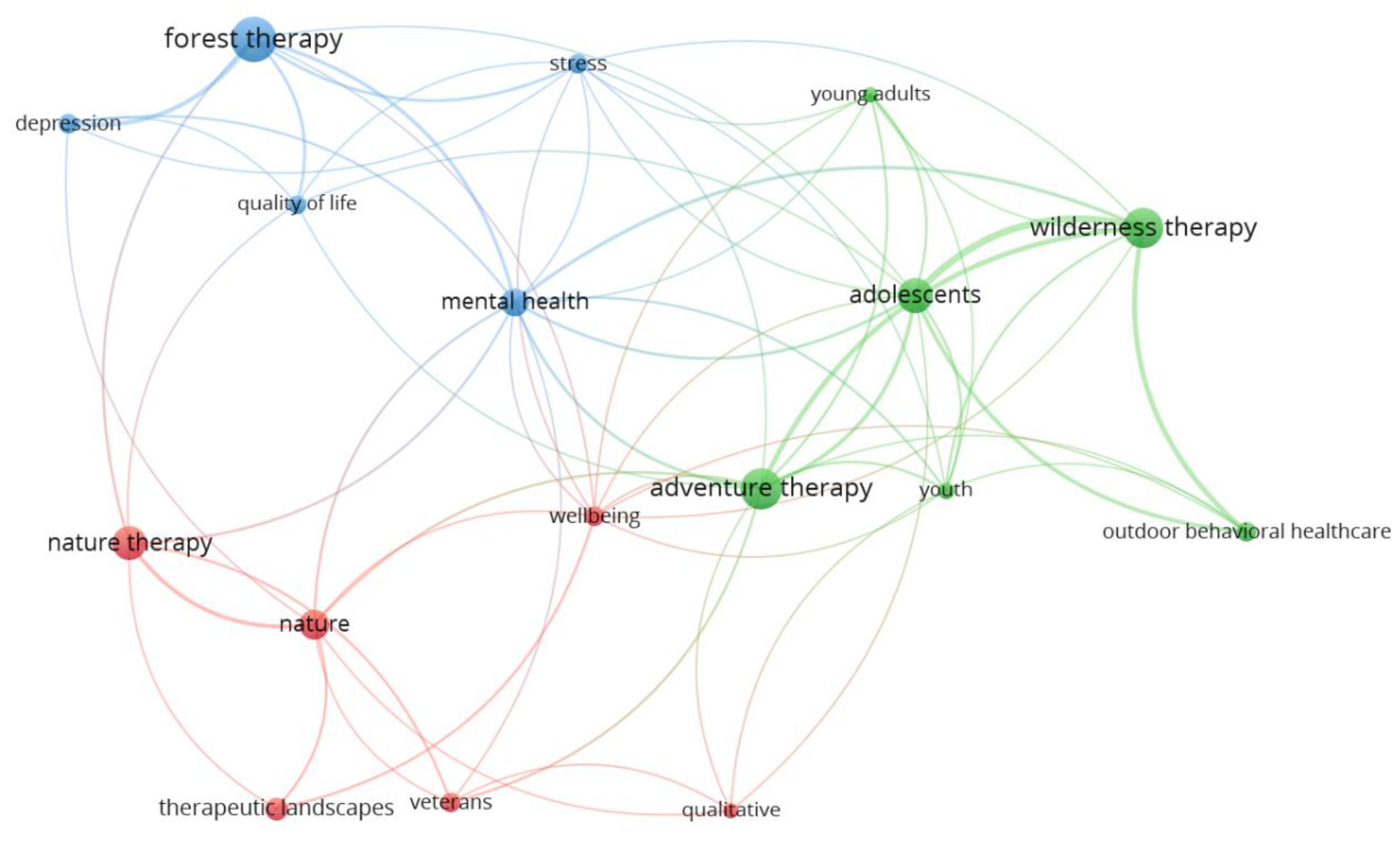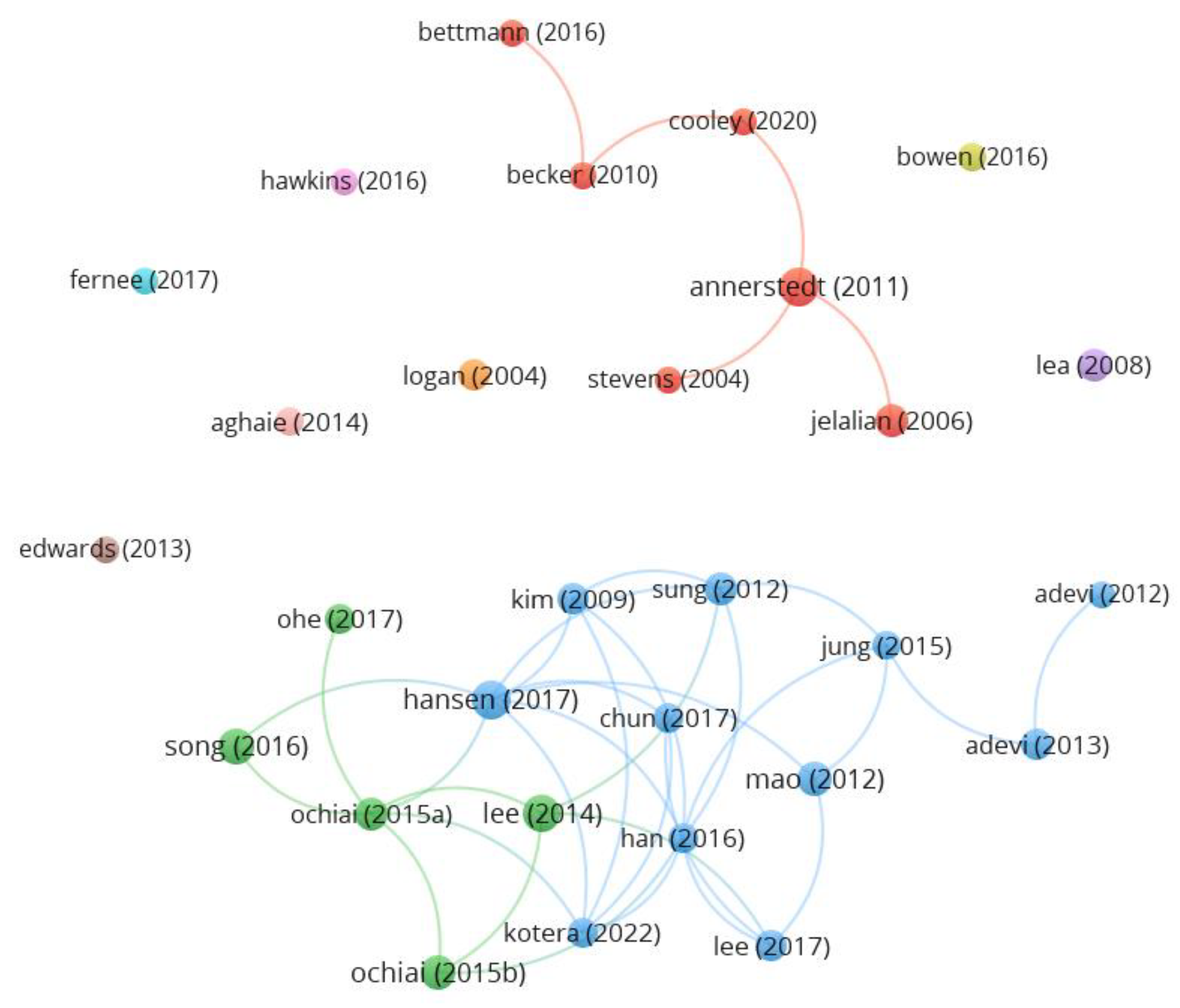Bibliometric Analysis of Nature-Based Therapy Research
Abstract
1. Introduction
2. Materials and Methods
2.1. Design and Data Source
2.2. Data Analysis
3. Results
3.1. Annual Publication Trends
3.2. WoS Categories
3.3. Publications Titles
3.4. Prolific and Influential Co-Authors
3.5. Countries/Regions
3.6. Author Keywords
3.7. Documents
4. Discussion
5. Conclusions
Supplementary Materials
Author Contributions
Funding
Institutional Review Board Statement
Informed Consent Statement
Data Availability Statement
Acknowledgments
Conflicts of Interest
References
- Grooten, M.; Almond, R.E.A. Living Planet Report—2018: Aiming Higher; WWF International: Gland, Switzerland, 2018; ISBN 978-2-940529-90-2. [Google Scholar]
- Hartig, T.; Mitchell, R.; de Vries, S.; Frumkin, H. Nature and Health. Annu. Rev. Public Health 2014, 35, 207–228. [Google Scholar] [CrossRef] [PubMed]
- Zhang, Z.; Wang, P.; Gao, Y.; Ye, B. Current Development Status of Forest Therapy in China. Healthcare 2020, 8, 61. [Google Scholar] [CrossRef] [PubMed]
- Song, C.; Ikei, H.; Miyazaki, Y. Physiological Effects of Nature Therapy: A Review of the Research in Japan. Int. J. Environ. Res. Public. Health 2016, 13, 781. [Google Scholar] [CrossRef] [PubMed]
- Gabrielsen, L.E.; Harper, N.J. The Role of Wilderness Therapy for Adolescents in the Face of Global Trends of Urbanization and Technification. Int. J. Adolesc. Youth 2018, 23, 409–421. [Google Scholar] [CrossRef]
- Pichler, C.; Freidl, J.; Bischof, M.; Kiem, M.; Weissboeck-Erdheim, R.; Huber, D.; Squarra, G.; Murschetz, P.C.; Hartl, A. Mountain Hiking vs. Forest Therapy: A Study Protocol of Novel Types of Nature-Based Intervention. Int. J. Environ. Res. Public Health 2022, 19, 3888. [Google Scholar] [CrossRef]
- Lu, N.; Song, C.; Kuronuma, T.; Ikei, H.; Miyazaki, Y.; Takagaki, M. The Possibility of Sustainable Urban Horticulture Based on Nature Therapy. Sustainability 2020, 12, 5058. [Google Scholar] [CrossRef]
- Harper, N.J. Outdoor Therapies: An Introduction to Practices, Possibilities, and Critical Perspectives; Routledge/Taylor & Francis Group: New York, NY, USA; Abingdon, UK, 2020; ISBN 978-0-367-36570-7. [Google Scholar]
- Revell, S.; Duncan, E.; Cooper, M. Helpful Aspects of Outdoor Therapy Experiences: An Online Preliminary Investigation. Couns. Psychother. Res. 2014, 14, 281–287. [Google Scholar] [CrossRef]
- Rutko, E.A.; Gillespie, J. Where’s the Wilderness in Wilderness Therapy? J. Exp. Educ. 2013, 36, 218–232. [Google Scholar] [CrossRef]
- Harper, N.J.; Fernee, C.R.; Gabrielsen, L.E. Nature’s Role in Outdoor Therapies: An Umbrella Review. Int. J. Environ. Res. Public Health 2021, 18, 5117. [Google Scholar] [CrossRef]
- Kim, J.-G.; Shin, W.-S. Forest Therapy Alone or with a Guide: Is There a Difference between Self-Guided Forest Therapy and Guided Forest Therapy Programs? Int. J. Environ. Res. Public Health 2021, 18, 6957. [Google Scholar] [CrossRef]
- Yu, C.-P.; Chen, H.-T.; Chao, P.-H.; Yin, J.; Tsai, M.-J. The Role of Social Context in Physiological and Psychological Restoration in a Forest: Case Study of a Guided Forest Therapy Program in Taiwan. Int. J. Environ. Res. Public Health 2021, 18, 10076. [Google Scholar] [CrossRef]
- Hansen, M.M.; Jones, R.; Tocchini, K. Shinrin-Yoku (Forest Bathing) and Nature Therapy: A State-of-the-Art Review. Int. J. Environ. Res. Public Health 2017, 14, 851. [Google Scholar] [CrossRef]
- Kotera, Y.; Richardson, M.; Sheffield, D. Effects of Shinrin-Yoku (Forest Bathing) and Nature Therapy on Mental Health: A Systematic Review and Meta-Analysis. Int. J. Ment. Health Addict. 2022, 20, 337–361. [Google Scholar] [CrossRef]
- Mao, G.-X.; Cao, Y.-B.; Lan, X.-G.; He, Z.-H.; Chen, Z.-M.; Wang, Y.-Z.; Hu, X.-L.; Lv, Y.-D.; Wang, G.-F.; Yan, J. Therapeutic Effect of Forest Bathing on Human Hypertension in the Elderly. J. Cardiol. 2012, 60, 495–502. [Google Scholar] [CrossRef] [PubMed]
- Mohan, A.; Malhotra, S.; Narayanan, M.; White, H.; Gaffney, H. PROTOCOL: The Effectiveness of Wilderness Therapy and Adventure Learning in Reducing Anti-Social and Offending Behaviour in Children and Young People at Risk of Offending. Campbell Syst. Rev. 2022, 18, e1270. [Google Scholar] [CrossRef]
- Fernee, C.R.; Gabrielsen, L.E.; Andersen, A.J.W.; Mesel, T. Unpacking the Black Box of Wilderness Therapy: A Realist Synthesis. Qual. Health Res. 2017, 27, 114–129. [Google Scholar] [CrossRef] [PubMed]
- Kraft, M.; Cornelius-White, J. Adolescent Experiences in Wilderness Therapy: A Systematic Review of Qualitative Studies. J. Creat. Ment. Health 2020, 15, 343–352. [Google Scholar] [CrossRef]
- Beck, N.; Wong, J.S. A Meta-Analysis of the Effects of Wilderness Therapy on Delinquent Behaviors Among Youth. Crim. Justice Behav. 2022, 49, 700–729. [Google Scholar] [CrossRef]
- Cooley, S.J.; Jones, C.R.; Kurtz, A.; Robertson, N. “Into the Wild”: A Meta-Synthesis of Talking Therapy in Natural Outdoor Spaces. Clin. Psychol. Rev. 2020, 77, 101841. [Google Scholar] [CrossRef]
- Cooley, S.J.; Jones, C.R.; Moss, D.; Robertson, N. Organizational Perspectives on Outdoor Talking Therapy: Towards a Position of “Environmental Safe Uncertainty”. Br. J. Clin. Psychol. 2022, 61, 132–156. [Google Scholar] [CrossRef]
- Clatworthy, J.; Hinds, J.; Camic, P.M. Gardening as a Mental Health Intervention: A Review. Ment. Health Rev. J. 2013, 18, 214–225. [Google Scholar] [CrossRef]
- Whear, R.; Coon, J.T.; Bethel, A.; Abbott, R.; Stein, K.; Garside, R. What Is the Impact of Using Outdoor Spaces Such as Gardens on the Physical and Mental Well-Being of Those with Dementia? A Systematic Review of Quantitative and Qualitative Evidence. J. Am. Med. Dir. Assoc. 2014, 15, 697–705. [Google Scholar] [CrossRef] [PubMed]
- Kamioka, H.; Tsutani, K.; Yamada, M.; Park, H.; Okuizumi, H.; Honda, T.; Okada, S.; Park, S.-J.; Kitayuguchi, J.; Abe, T.; et al. Effectiveness of Horticultural Therapy: A Systematic Review of Randomized Controlled Trials. Complement. Ther. Med. 2014, 22, 930–943. [Google Scholar] [CrossRef] [PubMed]
- Stern, C.; Chur-Hansen, A. An Umbrella Review of the Evidence for Equine-Assisted Interventions. Aust. J. Psychol. 2019, 71, 361–374. [Google Scholar] [CrossRef]
- Cooke, B.; Farrington, D. The Effectiveness of Dog-Training Programs in Prison. Prison J. 2016, 96, 854–876. [Google Scholar] [CrossRef]
- Azevedo, A. A New Theoretical Framework for Therapeutic Landscapes: Coastal (Blue), Forest (Green), Spiritual “Power Spots” (Gold) and Wilderness (Dark/White). J. Spat. Organ. Dyn. 2020, 8, 29–51. [Google Scholar]
- Brooke, K.; Williams, A. Iceland as a Therapeutic Landscape: White Wilderness Spaces for Well-Being. Geojournal 2021, 86, 1275–1285. [Google Scholar] [CrossRef]
- Satariano, B. Blue Therapeutic Spaces on Islands: Coastal Landscapes and Their Impact on the Health and Wellbeing of People in Malta. Isl. Stud. J. 2019, 14, 245–260. [Google Scholar] [CrossRef]
- Pijpker, R.; Veen, E.J.; Vaandrager, L.; Koelen, M.; Bauer, G.F. Developing an Intervention and Evaluation Model of Outdoor Therapy for Employee Burnout: Unraveling the Interplay Between Context, Processes, and Outcomes. Front. Psychol. 2022, 13, 785697. [Google Scholar] [CrossRef]
- Szczepanska-Gieracha, J.; Cieslik, B.; Serweta, A.; Klajs, K. Virtual Therapeutic Garden: A Promising Method Supporting the Treatment of Depressive Symptoms in Late-Life: A Randomized Pilot Study. J. Clin. Med. 2021, 10, 1942. [Google Scholar] [CrossRef]
- Picton, C.; Fernandez, R.; Moxham, L.; Patterson, C.F. Experiences of Outdoor Nature-Based Therapeutic Recreation Programs for Persons with a Mental Illness: A Qualitative Systematic Review. Jbi Evid. Synth. 2020, 18, 1820–1869. [Google Scholar] [CrossRef] [PubMed]
- Kondo, M.C.; South, E.C.; Branas, C.C. Nature-Based Strategies for Improving Urban Health and Safety. J. Urban Health Bull. N. Y. Acad. Med. 2015, 92, 800–814. [Google Scholar] [CrossRef] [PubMed]
- Di Carmine, F.; Berto, R. Contact with Nature Can Help ADHD Children to Cope with Their Symptoms. A State of the Evidence and Future Lines of Research. Vis. Sustain. 2020, 14, 1–11. [Google Scholar] [CrossRef]
- Sprague, N.; Berrigan, D.; Ekenga, C.C. An Analysis of the Educational and Health-Related Benefits of Nature-Based Environmental Education in Low-Income Black and Hispanic Children. Health Equity 2020, 4, 198–210. [Google Scholar] [CrossRef] [PubMed]
- Chan, Y.T.; Lau, H.Y.; Chan, W.Y.; Cheung, C.W.; Lui, W.; Chane-Thu, Y.S.J.; Dai, W.L.; To, K.C.; Cheng, H.L. Adventure Therapy for Child, Adolescent, and Young Adult Cancer Patients: A Systematic Review. Support. Care Cancer 2021, 29, 35–48. [Google Scholar] [CrossRef]
- Gill, E.; Goldenberg, M.; Starnes, H.; Phelan, S. Outdoor Adventure Therapy to Increase Physical Activity in Young Adult Cancer Survivors. J. Psychosoc. Oncol. 2016, 34, 184–199. [Google Scholar] [CrossRef]
- Meneguzzo, F.; Albanese, L.; Antonelli, M.; Baraldi, R.; Becheri, F.R.; Centritto, F.; Donelli, D.; Finelli, F.; Firenzuoli, F.; Margheritini, G.; et al. Short-Term Effects of Forest Therapy on Mood States: A Pilot Study. Int. J. Environ. Res. Public Health 2021, 18, 9509. [Google Scholar] [CrossRef]
- Bielinis, E.; Jaroszewska, A.; Lukowski, A.; Takayama, N. The Effects of a Forest Therapy Programme on Mental Hospital Patients with Affective and Psychotic Disorders. Int. J. Environ. Res. Public Health 2020, 17, 118. [Google Scholar] [CrossRef]
- Chun, M.H.; Chang, M.C.; Lee, S.-J. The Effects of Forest Therapy on Depression and Anxiety in Patients with Chronic Stroke. Int. J. Neurosci. 2017, 127, 199–203. [Google Scholar] [CrossRef]
- Han, J.-W.; Choi, H.; Jeon, Y.-H.; Yoon, C.-H.; Woo, J.-M.; Kim, W. The Effects of Forest Therapy on Coping with Chronic Widespread Pain: Physiological and Psychological Differences between Participants in a Forest Therapy Program and a Control Group. Int. J. Environ. Res. Public Health 2016, 13, 255. [Google Scholar] [CrossRef]
- Donthu, N.; Kumar, S.; Mukherjee, D.; Pandey, N.; Lim, W.M. How to Conduct a Bibliometric Analysis: An Overview and Guidelines. J. Bus. Res. 2021, 133, 285–296. [Google Scholar] [CrossRef]
- Wang, X.; Gong, X.-F.; Xiong, K.-X.; Guo, D.-S.; Liu, L.-J.; Lin, C.-M.; Chang, W.-Y. Mapping of Research in the Field of Forest Therapy-Related Issues: A Bibliometric Analysis for 2007-2021. Front. Psychol. 2022, 13, 930713. [Google Scholar] [CrossRef]
- Huang, X.; Yang, Z.; Zhang, J.; Wang, R.; Fan, J.; Zhang, H.; Xu, R.; Li, X.; Yu, S.; Long, L.; et al. A Bibliometric Analysis Based on Web of Science: Current Perspectives and Potential Trends of SMAD7 in Oncology. Front. Cell Dev. Biol. 2022, 9, 712732. [Google Scholar] [CrossRef] [PubMed]
- Shi, J.; Gao, Y.; Ming, L.; Yang, K.; Sun, Y.; Chen, J.; Shi, S.; Geng, J.; Li, L.; Wu, J.; et al. A Bibliometric Analysis of Global Research Output on Network Meta-Analysis. BMC Med. Inform. Decis. Mak. 2021, 21, 144. [Google Scholar] [CrossRef] [PubMed]
- Yu, Y.; Li, Y.; Zhang, Z.; Gu, Z.; Zhong, H.; Zha, Q.; Yang, L.; Zhu, C.; Chen, E. A Bibliometric Analysis Using VOSviewer of Publications on COVID-19. Ann. Transl. Med. 2020, 8, 816. [Google Scholar] [CrossRef] [PubMed]
- Price, D.D.S. A General Theory of Bibliometric and Other Cumulative Advantage Processes. J. Am. Soc. Inf. Sci. 1976, 27, 292–306. [Google Scholar] [CrossRef]
- Dobrov, G.M.; Randolph, R.H.; Rauch, W.D. New Options for Team Research via International Computer Networks. Scientometrics 1979, 1, 387–404. [Google Scholar] [CrossRef]
- DeShazo, J.P.; LaVallie, D.L.; Wolf, F.M. Publication Trends in the Medical Informatics Literature: 20 Years of “Medical Informatics” in MeSH. BMC Med. Inform. Decis. Mak. 2009, 9, 7. [Google Scholar] [CrossRef]
- Goffman, W.; Warren, K.S. Dispersion of Papers among Journals Based on a Mathematical Analysis of Two Diverse Medical Literatures. Nature 1969, 221, 1205–1207. [Google Scholar] [CrossRef]
- Nash-Stewart, C.E.; Kruesi, L.M.; Del Mar, C.B. Does Bradford’s Law of Scattering Predict the Size of the Literature in Cochrane Reviews? J. Med. Libr. Assoc. JMLA 2012, 100, 135–138. [Google Scholar] [CrossRef]
- Venable, G.T.; Shepherd, B.A.; Loftis, C.M.; McClatchy, S.G.; Roberts, M.L.; Fillinger, M.E.; Tansey, J.B.; Klimo, P. Bradford’s Law: Identification of the Core Journals for Neurosurgery and Its Subspecialties. J. Neurosurg. 2016, 124, 569–579. [Google Scholar] [CrossRef] [PubMed]
- Venable, G.T.; Shepherd, B.A.; Roberts, M.L.; Taylor, D.R.; Khan, N.R.; Klimo, P. An Application of Bradford’s Law: Identification of the Core Journals of Pediatric Neurosurgery and a Regional Comparison of Citation Density. Childs Nerv. Syst. 2014, 30, 1717–1727. [Google Scholar] [CrossRef] [PubMed]
- Kushairi, N.; Ahmi, A. Flipped Classroom in the Second Decade of the Millenia: A Bibliometrics Analysis with Lotka’s Law. Educ. Inf. Technol. 2021, 26, 4401–4431. [Google Scholar] [CrossRef] [PubMed]
- Yie, K.-Y.; Chien, T.-W.; Chen, C.-H.; Yeh, Y.-T.; Lin, J.-C.J.; Lai, F.-J. Suitability of H- and x-Indices for Evaluating Authors’ Individual Research Achievements in a given Short Period of Years: A Bibliometric Analysis. Medicine (Baltimore) 2021, 100, e25016. [Google Scholar] [CrossRef] [PubMed]
- Hirsch, J.E. An Index to Quantify an Individual’s Scientific Research Output. Proc. Natl. Acad. Sci. USA 2005, 102, 16569–16572. [Google Scholar] [CrossRef]
- Rodrigues-Santana, L.; Adsuar, J.C.; Denche-Zamorano, Á.; Vega-Muñoz, A.; Salazar-Sepúlveda, G.; Contreras-Barraza, N.; Galán-Arroyo, C.; Louro, H. Bibliometric Analysis of Studies on Whole Body Electromyostimulation. Biology 2022, 11, 1205. [Google Scholar] [CrossRef]
- Zipf, G.K. Selected Studies of the Principle of Relative Frequency in Language; Harvard University Press: Cambridge, MA, USA, 2013; ISBN 978-0-674-43492-9. [Google Scholar]
- Contreras-Barraza, N.; Madrid-Casaca, H.; Salazar-Sepúlveda, G.; Garcia-Gordillo, M.Á.; Adsuar, J.C.; Vega-Muñoz, A. Bibliometric Analysis of Studies on Coffee/Caffeine and Sport. Nutrients 2021, 13, 3234. [Google Scholar] [CrossRef]
- Flach, E. The significance of the forest for the therapeutic value of the German low mountain range. Dtsch. Med. Wochenschr. 1937, 63, 628–632. [Google Scholar] [CrossRef]
- Annerstedt, M.; Wahrborg, P. Nature-Assisted Therapy: Systematic Review of Controlled and Observational Studies. Scand. J. Public Health 2011, 39, 371–388. [Google Scholar] [CrossRef]
- Lee, J.; Tsunetsugu, Y.; Takayama, N.; Park, B.-J.; Li, Q.; Song, C.; Komatsu, M.; Ikei, H.; Tyrvainen, L.; Kagawa, T.; et al. Influence of Forest Therapy on Cardiovascular Relaxation in Young Adults. Evid. Based Complement. Alternat. Med. 2014, 2014, 834360. [Google Scholar] [CrossRef]
- Liang, Y.-D.; Li, Y.; Zhao, J.; Wang, X.-Y.; Zhu, H.-Z.; Chen, X.-H. Study of Acupuncture for Low Back Pain in Recent 20 Years: A Bibliometric Analysis via CiteSpace. J. Pain Res. 2017, 10, 951–964. [Google Scholar] [CrossRef] [PubMed]
- Ali, Q.; Heldal, I.; Helgesen, C.G. A Bibliometric Analysis of Virtual Reality-Aided Vision Therapy. In Studies in Health Technology and Informatics; Mantas, J., Gallos, P., Zoulias, E., Hasman, A., Househ, M.S., Diomidous, M., Liaskos, J., Charalampidou, M., Eds.; IOS Press: Amsterdam, The Netherlands, 2022; ISBN 978-1-64368-290-7. [Google Scholar]
- Zyoud, S.H.; Al-Jabi, S.W. Mapping the Situation of Research on Coronavirus Disease-19 (COVID-19): A Preliminary Bibliometric Analysis during the Early Stage of the Outbreak. BMC Infect. Dis. 2020, 20, 561. [Google Scholar] [CrossRef] [PubMed]
- Pawassar, C.M.; Tiberius, V. Virtual Reality in Health Care: Bibliometric Analysis. JMIR Serious Games 2021, 9, e32721. [Google Scholar] [CrossRef] [PubMed]





| Web of Science Categories | Number of Documents |
|---|---|
| Public, Environmental, and Occupational Health | 38 |
| Environmental Sciences | 33 |
| Psychology, Clinical | 30 |
| Environmental Studies | 20 |
| Forestry | 20 |
| Journals (Publisher) | Docs | %Docs | Cites | JIF/JCI | Q | %OA |
|---|---|---|---|---|---|---|
| International Journal of Environmental Research and Public Health (MDPI) | 33 | 13.9 | 824 | 4.614 (JIF) | Q1 | 95 |
| Urban Forestry & Urban Greening (Elsevier GMBH) | 13 | 5.5 | 293 | 5.766 (JIF) | Q1 | 10.2 |
| Journal of Adventure Education and Outdoor Learning (Routledge Journals, Taylor & Francis) | 7 | 2.9 | 22 | 0.97 (JCI) | Q2 (JCI) | 15.8 |
| Journal of Experiential Education (Sage Publications) | 7 | 2.9 | 51 | 0.99 (JCI) | Q2 (JCI) | 7 |
| Contemporary Family Therapy (Springer) | 6 | 2.5 | 43 | 0.36 (JCI) | Q3 (JCI) | 4.8 |
| Frontiers in Psychology (Frontiers Media) | 6 | 2.5 | 6 | 4.232 (JIF) | Q1 | 99.5 |
| Women & Therapy (Routledge Journals, Taylor & Francis) | 6 | 2.5 | 63 | 1.484 (JIF) | Q3 | 1.2 |
| Bradford’s Zones | Journals (Publishers) | Docs | Cit | %Cit | JIF | Q. | %OA |
|---|---|---|---|---|---|---|---|
| Core | International Journal of Environmental Research and Public Health (MDPI) | 33 | 824 | 23.4 | 4.614 | Q1 | 95 |
| Urban Forestry & Urban Greening (Elsevier GMBH) | 13 | 293 | 8.3 | 5.766 | Q1 | 10.2 | |
| Zone I | Scandinavian Journal of Public Health (Sage Publications) | 1 | 171 | 4.9 | 3.199 | Q2 | 33.2 |
| Evidence-Based Complementary and Alternative Medicine (Hindawi) | 1 | 147 | 4.2 | 2.650 | Q3 | 98.7 | |
| Journal of Cardiology (Elsevier) | 1 | 103 | 2.9 | 2.974 | Q3 | 8 | |
| Child & Youth Care Forum (Springer) | 4 | 91 | 2.6 | 2.203 | Q3 | 18.8 | |
| International Journal of Obesity (Springer Nature) | 1 | 91 | 2.6 | 5.551 | Q2 | 23 | |
| Clinical and Experimental Hypertension (Taylor & Francis) | 1 | 90 | 2.6 | 2.088 | Q4 | 3.8 | |
| Area (Wiley) | 1 | 83 | 2.4 | 2.057 | Q3 | 24.9 | |
| BMJ—British Medical Journal (BMJ Publishing Group) | 1 | 77 | 2.2 | 93.467 | Q1 | 81.9 | |
| Journal of Child and Family Studies (Springer) | 3 | 71 | 2.0 | 2.784 | Q2 | 10.8 | |
| Psychiatry Investigation (Korean Neuropsychiatric Assoc) | 1 | 67 | 1.9 | 3.202 | Q3 | 99.5 | |
| Women & Therapy (Routledge Journals, Taylor & Francis) | 6 | 63 | 1.8 | 1.484 | Q3 | 1.2 | |
| International Journal of Neuroscience (Taylor & Francis) | 1 | 62 | 1.8 | 2.590 | Q4 | 2.1 |
| Co-authors (Most Cited Documents) | Affiliation/Country-Region | Documents | Citations | Cit/Doc |
|---|---|---|---|---|
| Ikei, Harumi * | Chiba University/Japan | 8 | 597 | 75 |
| Miyazaki, Yoshifumi * | Chiba University/Japan | 8 | 597 | 75 |
| Song, Chorong * | Kongju National University/South Korea | 8 | 597 | 75 |
| Kagawa, Takahide * | Chiba University/Japan | 4 | 382 | 96 |
| Woo, Jong-Min * | Inje University/South Korea | 4 | 251 | 63 |
| Gabrielsen, Leiv E. | Sorlandet Sykehus/Norway | 8 | 100 | 13 |
| Tucker, Anita R. | University of New Hampshire/USA | 9 | 92 | 10 |
| Bettmann, Joanna E. | University of Utah/USA | 8 | 87 | 11 |
| Fernee, Carina R. | University of Agder/Norway | 8 | 78 | 10 |
| Harper, Nevin J. | University of Victoria/Canada | 9 | 78 | 9 |
| Stigsdotter, Ulrika Karlsson | University of Copenhagen/Denmark | 6 | 76 | 13 |
| Sidenius, Ulrik | University of Copenhagen/Denmark | 5 | 68 | 14 |
| Poulsen, Dorthe Varning | University of Copenhagen/Denmark | 7 | 64 | 9 |
| Mesel, Terje | University of Agder/Norway | 4 | 63 | 16 |
| Norton, Christine Lynn | Texas State University System/USA | 5 | 55 | 11 |
| Shin, Won-Sop | Chungbuk National University/South Korea | 8 | 42 | 5 |
| Kim, Jin-Gun | Chungbuk National University/South Korea | 4 | 19 | 5 |
Disclaimer/Publisher’s Note: The statements, opinions and data contained in all publications are solely those of the individual author(s) and contributor(s) and not of MDPI and/or the editor(s). MDPI and/or the editor(s) disclaim responsibility for any injury to people or property resulting from any ideas, methods, instructions or products referred to in the content. |
© 2023 by the authors. Licensee MDPI, Basel, Switzerland. This article is an open access article distributed under the terms and conditions of the Creative Commons Attribution (CC BY) license (https://creativecommons.org/licenses/by/4.0/).
Share and Cite
Rodríguez-Redondo, Y.; Denche-Zamorano, A.; Muñoz-Bermejo, L.; Rojo-Ramos, J.; Adsuar, J.C.; Castillo-Paredes, A.; Vega-Muñoz, A.; Barrios-Fernandez, S. Bibliometric Analysis of Nature-Based Therapy Research. Healthcare 2023, 11, 1249. https://doi.org/10.3390/healthcare11091249
Rodríguez-Redondo Y, Denche-Zamorano A, Muñoz-Bermejo L, Rojo-Ramos J, Adsuar JC, Castillo-Paredes A, Vega-Muñoz A, Barrios-Fernandez S. Bibliometric Analysis of Nature-Based Therapy Research. Healthcare. 2023; 11(9):1249. https://doi.org/10.3390/healthcare11091249
Chicago/Turabian StyleRodríguez-Redondo, Yeray, Angel Denche-Zamorano, Laura Muñoz-Bermejo, Jorge Rojo-Ramos, Jose Carmelo Adsuar, Antonio Castillo-Paredes, Alejandro Vega-Muñoz, and Sabina Barrios-Fernandez. 2023. "Bibliometric Analysis of Nature-Based Therapy Research" Healthcare 11, no. 9: 1249. https://doi.org/10.3390/healthcare11091249
APA StyleRodríguez-Redondo, Y., Denche-Zamorano, A., Muñoz-Bermejo, L., Rojo-Ramos, J., Adsuar, J. C., Castillo-Paredes, A., Vega-Muñoz, A., & Barrios-Fernandez, S. (2023). Bibliometric Analysis of Nature-Based Therapy Research. Healthcare, 11(9), 1249. https://doi.org/10.3390/healthcare11091249











